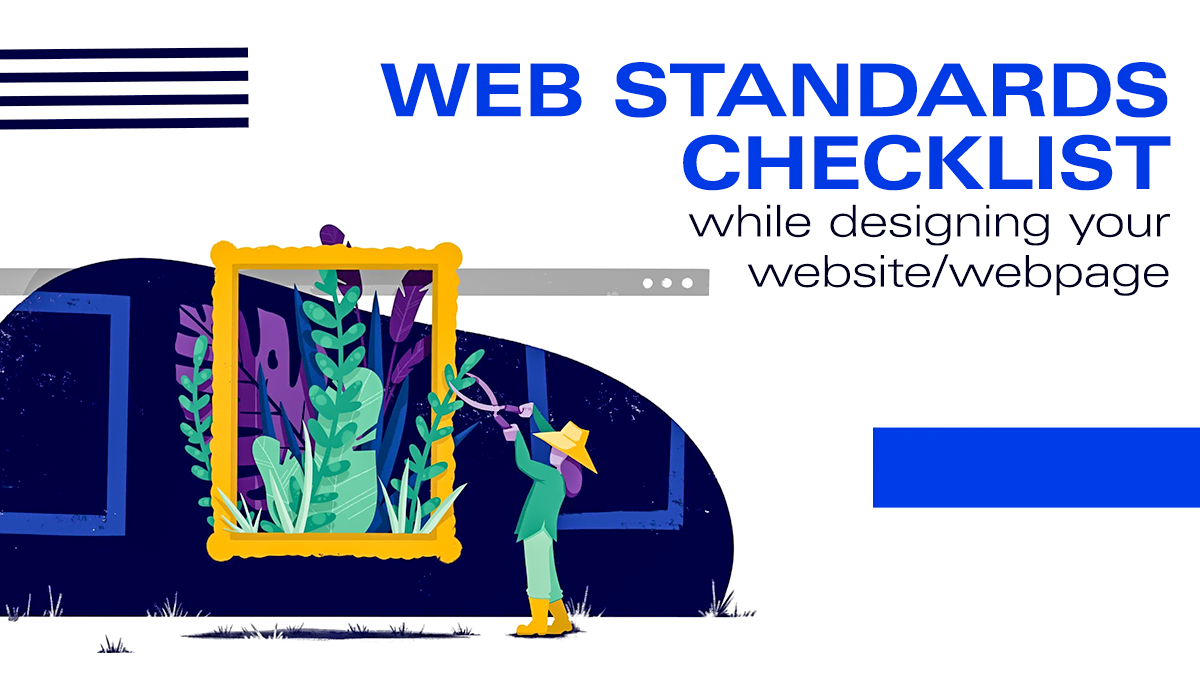
Web Standards Checklist While Designing Your Website/Webpage
Your website has 0.05 seconds to impress visitors before they judge your business. Beautiful design isn't enough—modern users and search engines demand fast loading, mobile-friendly sites that work perfectly across all devices. Web standards are your foundation for online success, ensuring better user experience, higher search rankings, and more conversions. Skip them, and you're losing customers daily.
In the online market, you never get a second chance to make a first impression. Your website is often the first touchpoint between your brand and potential customers, and within 0.05 seconds, visitors form an opinion about your business. That split-second judgment can make or break a deal worth thousands.
But here's the reality check: stunning visuals alone won't cut it anymore. Today's users expect lightning-fast loading times, seamless mobile experiences, and intuitive navigation. Search engines are equally demanding, rewarding websites that follow established web standards while penalizing those that don't.
Web standards aren't just technical jargon—they're your roadmap to online success. They ensure your website works flawlessly across all devices and browsers, loads quickly, ranks higher in search results, and provides an exceptional user experience that converts visitors into customers.
Think of web standards as the foundation of a house. You might have the most beautiful interior design, but without a solid foundation, everything crumbles. Similarly, your website might look gorgeous, but if it fails to meet modern web standards, you're losing potential customers every single day.
Following a comprehensive web standards checklist isn't optional—it's essential for staying competitive in today's digital marketplace.
When you decide to make your website from scratch, there are certain strict guidelines or checklists that need to be taken care off. But have you considered web standards? If you have not, you must.
What are Web Standards?
These are the certain formal specifications that need to be adhered while building a website. These are internet rules. It is less about the front head of the website and more about how to deal with the backend.
Web standards touch on subjects like- HTML, design, development and also consumer devices. These are made to bring consistency and strength to the very core of the web.
Crux, a website designing company in Delhi NCR lists few of the main web standards for the convenience of the companies that are building up their website:
Apt HTML, JAVASCRIPT and CSS
A code that is not written well can be a cause of several problems, especially for the performance of the website. Any website design company in Gurgaon, India or anywhere else in the world will tell you that it is also eligible to introduce bugs and you certainly do not want it.
HTML, JAVASCRIPT and CSS is the backbone of the webs, so it is crucial to follow strict standards pertaining to how it can be used and manipulated into driving traffic. When we standardize the code, it becomes easier for all developers and designers to speak the same language, and then it becomes even easier to comprehend what others want to communicate.
Valid Graphics
This is one of the important aspects for any web designer. The web standard for graphics are as follow:
- Photos in PNG format
- Data visualization in SVG format
- CSS must be used to enhance HTML
- Gradients, shapes and other effects in Canvas API format
- Vector graphics on WebCGM format
It is of utmost importance to adhere to these standards if you wish your website to perform exceptionally well.
A Good Mobile Responsiveness
Most of the visitors on your website will be the ones on-the-go. The advancement has led people to use their smartphones for each activity that required a desktop once. Same goes with the website. For smarter website that is accessible on mobile phones as well, Crux, best web development company in Delhi NCR presents you few rules for it:
- Design compelling and smooth user interface
- Content must be designed to automatically adjust to different layouts
- Create immersive audio/visuals for great experience on mobile phones
- Use device specific interaction mechanism
Also, processing payments and other tools must be incorporated in a way that the mobile features do not interrupt it.
Classic Web Architecture
It definitely is about the way we store information and the standards that needs to be followed are:
- Encoding
- HTTP and HTTPs
- XML
- Character sets
- URIs and URLs
By identifying the above-mentioned tools, the website becomes more global-friendly.
Global Accessibility
The World Wide Web has a larger part known as Web Accessibility Initiative (WAI) consortium:
Unlike few standards mentioned in this blog, standardizing accessibility is not as easy and it is a big deal. It is not just something that affects the web developer code or web designers, it affects everyone that contributes to the website like writer, tester, project manager and even policy makers. It is important to check on the standards of accessibility.
Crux Creative Solutions is a website development company in Gurgaon, we have our team of expert website designers who adhere to all the standards. We take pride in designing the profit reaping website for many renowned names in the industry.
For more information, contact us.
FAQs
1. How often should I update my website to maintain web standards compliance?
Web standards evolve constantly, so regular updates are crucial. Perform basic checks monthly for broken links, loading speeds, and mobile functionality. Quarterly reviews should cover security updates, browser compatibility, and accessibility features. Annual comprehensive audits ensure your site meets the latest standards. Staying proactive prevents major overhauls and maintains optimal performance.
2. Do web standards really impact my website's conversion rates?
Absolutely! Standards-compliant websites typically see 20-50% higher conversion rates. Fast loading times reduce bounce rates, mobile optimization captures smartphone users, and proper accessibility reaches wider audiences. Clean code ensures forms work correctly, checkout processes run smoothly, and call-to-action buttons function properly across all devices, directly boosting sales and leads.
3. What happens if I ignore web standards completely?
Ignoring web standards creates a cascade of problems: poor search rankings, high bounce rates, lost mobile traffic, security vulnerabilities, and browser compatibility issues. Users abandon slow or broken sites within seconds. You'll face declining organic traffic, reduced credibility, potential legal issues with accessibility compliance, and ultimately, significant revenue loss.
4. Are there industry-specific web standards I should know about?
Yes! Healthcare sites need HIPAA compliance, financial services require strict security standards, and e-commerce sites must follow PCI DSS guidelines. Government sites need Section 508 accessibility compliance. Educational institutions have specific accessibility requirements. Legal, real estate, and other industries have unique standards beyond general web compliance requirements.
5. Can outdated web standards hurt my brand reputation?
Definitely. A non-compliant website signals unprofessionalism and outdated business practices. Users associate slow, broken, or poorly designed sites with unreliable companies. In today's digital-first world, your website represents your brand quality. Poor web standards can damage customer trust, reduce referrals, and hurt your competitive position in the marketplace.














